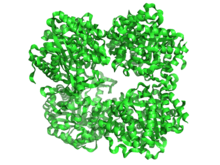Beta-glucosidase
| β-glucosidase | |||||||||
|---|---|---|---|---|---|---|---|---|---|
 The structure of beta-glucosidase A from bacterium Clostridium cellulovorans.[1] | |||||||||
| Identifiers | |||||||||
| EC number | 3.2.1.21 | ||||||||
| CAS number | 9001-22-3 | ||||||||
| Databases | |||||||||
| IntEnz | IntEnz view | ||||||||
| BRENDA | BRENDA entry | ||||||||
| ExPASy | NiceZyme view | ||||||||
| KEGG | KEGG entry | ||||||||
| MetaCyc | metabolic pathway | ||||||||
| PRIAM | profile | ||||||||
| PDB structures | RCSB PDB PDBe PDBsum | ||||||||
| Gene Ontology | AmiGO / EGO | ||||||||
| |||||||||
Beta-glucosidase catalyzes the hydrolysis of the glycosidic bonds to terminal non-reducing residues in beta-D-glucosides and oligosaccharides, with release of glucose.[2]
Synonyms, derivatives, and related enzymes include gentiobiase, cellobiase, emulsin,[3] elaterase, aryl-beta-glucosidase, beta-D-glucosidase, beta-glucoside glucohydrolase, arbutinase, amygdalinase, p-nitrophenyl beta-glucosidase, primeverosidase, amygdalase, linamarase, salicilinase, and beta-1,6-glucosidase.
Cellulose is a polymer composed of beta-1,4-linked glucosyl residues. Cellulases (endoglucanases), cellobiosidases (exoglucanases), and beta-glucosidases are required by organisms (some fungi, bacteria) that can consume it. These enzymes are powerful tools for degradation of plant cell walls by pathogens and other organisms consuming plant biomass.
| glucosidase, beta, acid 3 (cytosolic) | |
|---|---|
| Identifiers | |
| Symbol | GBA3 |
| Alt. symbols | CBGL1, KLRP |
| Entrez | 57733 |
| HUGO | 19069 |
| OMIM | 606619 |
| RefSeq | NM_020973 |
| UniProt | Q9H227 |
| Other data | |
| EC number | 3.2.1.21 |
| Locus | Chr. 4 p15.31 |
See also
- Amygdalin beta-glucosidase
- Prunasin beta-glucosidase
- Vicianin beta-glucosidase
- Glucosylceramidase, a related enzyme
- Cellulase, a suite of enzymes produced chiefly by fungi, bacteria, and protozoans that catalyze cellulolysis (i.e. the hydrolysis of cellulose)
References
- ↑ PDB: 3AHX; Jeng, W.-Y.; Wang, N.-C.; Lin, M.-H.; Lin, C.T.; Liaw, Y.C.; Chang, W.J.; Liu, C.I.; Liang, P.H.; Wang A.H.J. (August 2010). "Structural and functional analysis of three beta-glucosidases from bacterium Clostridium cellulovorans, fungus Trichoderma reesei and termite Neotermes koshunensis.". J.Struc.Biol. 173 (1): 46–56. doi:10.1016/j.jsb.2010.07.008. PMID 20682343.; rendered via PyMOL.
- ↑ Cox, Michael; Lehninger, Albert L; Nelson, David R. (2000). Lehninger principles of biochemistry. New York: Worth Publishers. pp. 306–308. ISBN 1-57259-931-6.
- ↑ George Mann, Frederick; Charles Saunders, Bernard (1975). Practical Organic Chemistry (4th ed.). London: Longman. pp. 509–517. ISBN 9788125013808. Retrieved 1 February 2016.
External links
- beta-Glucosidase at the US National Library of Medicine Medical Subject Headings (MeSH)
- GO-database listing 'GO:0016162 cellulose 1,4-beta-cellobiosidase activity'
- Risk Assessment Summary, CEPA 1999. Trichoderma reesei P59G